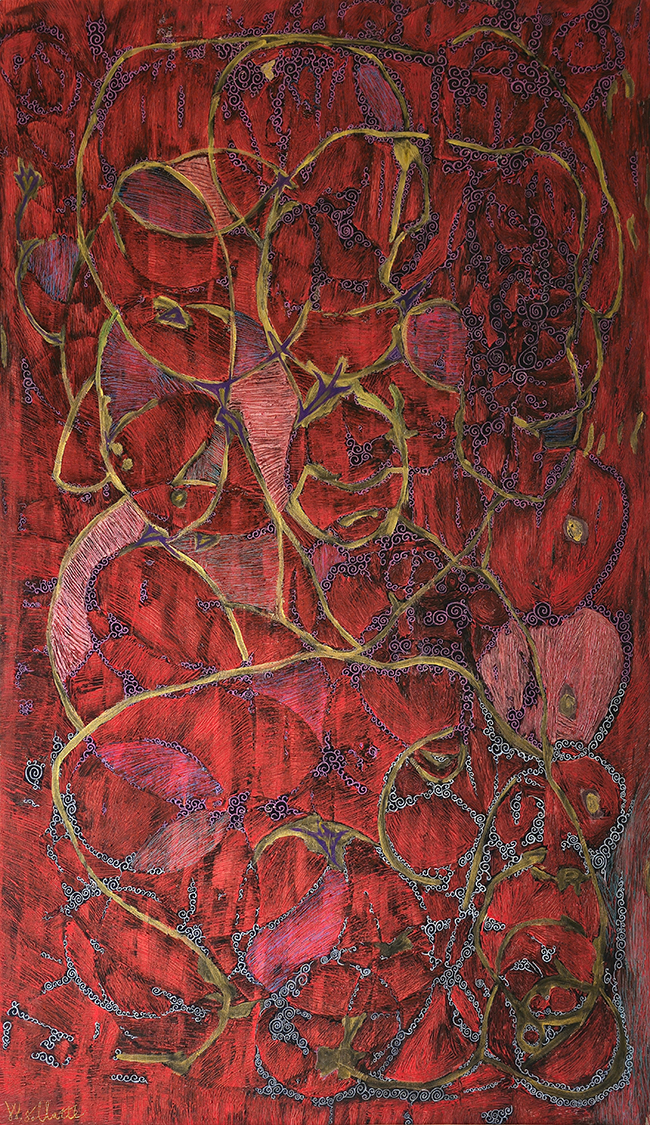Waseem Sallam is a Libyan painter in his mid-thirties, currently based in Nijmegen, Netherlands. His art emerges from the depths of personal experiences shaped by war, loss, and resilience. Through the philosophy of visual art, he transforms these complex emotions into abstract, thought-provoking works. Sallam’s goal is to create a dialogue between the viewer and the metaphysical concepts of existence, using a refined visual language that speaks beyond the surface. His work explores profound themes, inviting contemplation of life’s unseen dimensions and offering viewers a chance to engage with questions about the soul, identity, and continuity.

One of Sallam’s defining works is Spiritual Cloning. This painting delves into the mystical notion of the soul’s replication across dimensions of existence. Rather than focusing on the physical or literal aspects of cloning, it investigates the spiritual essence and how it can be replicated and transformed through cycles of life, death, and rebirth. The abstract nature of the painting allows for multiple interpretations, making it a deeply personal experience for the viewer.
Spiritual Cloning is composed of intricate layers of paint, each one representing a different stage or aspect of the soul’s journey. These layers seem to float within the composition, creating a sense of fluidity and transformation. Sallam uses abstract, fluid forms to evoke the idea of the soul being in a constant state of change, while also maintaining a certain continuity. The lack of sharp lines or defined figures reinforces this feeling of movement and ambiguity, suggesting that the soul’s journey is not a straightforward path but a complex, ever-evolving process.
At first glance, the painting might appear chaotic or disjointed, but upon closer inspection, it reveals a deliberate structure beneath the surface. The layers of paint overlap and interact in ways that mimic the cycles of life and death. Sallam’s use of color plays a crucial role here; soft, muted tones blend together, creating a sense of calm and reflection. These tones are occasionally interrupted by darker, more intense hues, hinting at the emotional and spiritual turmoil that often accompanies transformation.
The title, Spiritual Cloning, invites the viewer to reflect on the nature of identity and continuity. If the soul can be cloned or replicated, what does that mean for our sense of self? Are we truly the same across different lifetimes or dimensions, or do we undergo fundamental changes with each new experience? These are complex questions that the painting raises but does not necessarily answer. Instead, it encourages the viewer to sit with the uncertainty, to contemplate the mysteries of existence without needing to resolve them.
One of the aspects of Spiritual Cloning is its exploration of the metaphysical. The painting suggests that there is more to existence than what we can see or touch. By using abstract forms and a lack of clear representation, Sallam opens up space for the viewer to imagine what lies beyond the physical world. The fluid, almost otherworldly shapes within the painting hint at forces that exist beyond our understanding — the soul’s journey, the cycle of life and death, the replication of spiritual essence across dimensions.
The painting’s composition is intentionally open-ended, allowing viewers to bring their own interpretations and emotions to the experience. There is no single way to understand Spiritual Cloning — each viewer will see something different, depending on their own perspectives on life, death, and the nature of the soul. This openness is a key part of Sallam’s approach to art. He isn’t interested in providing definitive answers or clear messages. Instead, he creates space for reflection, inviting viewers to explore their own thoughts and emotions.
Sallam’s work, including Spiritual Cloning, challenges the viewer to engage with deeper philosophical questions about existence. His paintings are not meant to be easy or straightforward; they require time and contemplation. The abstract nature of his compositions encourages viewers to look beyond the surface, to think about what lies beneath the visible world. By doing so, he creates a dialogue between the viewer and the metaphysical, offering a glimpse into the mysteries of life and the soul.
In Spiritual Cloning, Wassim Sallam explores themes that are universal yet deeply personal. The painting speaks to the continuity of existence, the transformation of the soul, and the uncertain nature of identity. Through his abstract visual language, Sallam invites us to reflect on these themes in our own way, creating a rich and thought-provoking experience that lingers long after we’ve stepped away from the canvas.

